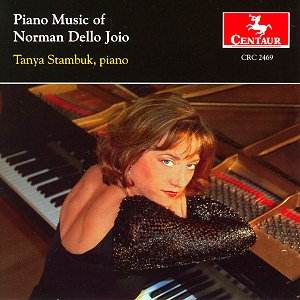Dello
Joio came of a musical family. He studied with Wagenaar and Hindemith
soon coming to the conviction that his music must be accessible
to the public ... and so it is. His lyrical proclivities are instantly
announced in the Prelude to a Young Musician which
is lyrical in the manner of early Fauré. Diversions
plays around the bel canto line with a lacing of neo-Baroque
always alert and eager. The Chorale (tr.5) from Diversions
uses the traditional tune In dulci jubilo. The Introduction
and Fantasies tends towards the monumental, making respectful,
ingenious sport of the hymn Praise God from Whom all Blessings
Flow. The aggressive Fantasy II movement is cross-hatched
with Shostakovich-like writing from the Preludes and Fugues
with a sprinkling of Grainger along the way. Fantasy III
recalled the bluesy flavour of Robert Nathaniel Dett's suite
In the Bottoms. The Suite aims to recreate
moods from the poetry of Carl Sandburg. These range from darkly
reflective, to upstart brio (Bright tr.13), to the
dark ruffled waters of Calm and the irritability and unstable
ferocity of the finale. The six Lyric Pieces for the Young
are didactics but their postcard imagination is vivid
and the invention is not at all time-serving. The Etudes
sometimes recall the elaboration of Godowsky in the Java Suite.
There is an engaging peppery dissonant shading in these six pieces.
The Third Piano Sonata returns to his lyrical heartland
with some jazzy syncopation like Lambert at tr.29 and Milhaud
at tr. 31 along the way.
Tanya
Stambuk is all we might hope for: alert and eager in riffs and
speed while welcoming of the many lyrical opportunities offered
by this neglected music. Will appeal to those who are already
captivated by the piano music of Moeran and Constant Lambert.
Rob
Barnett
